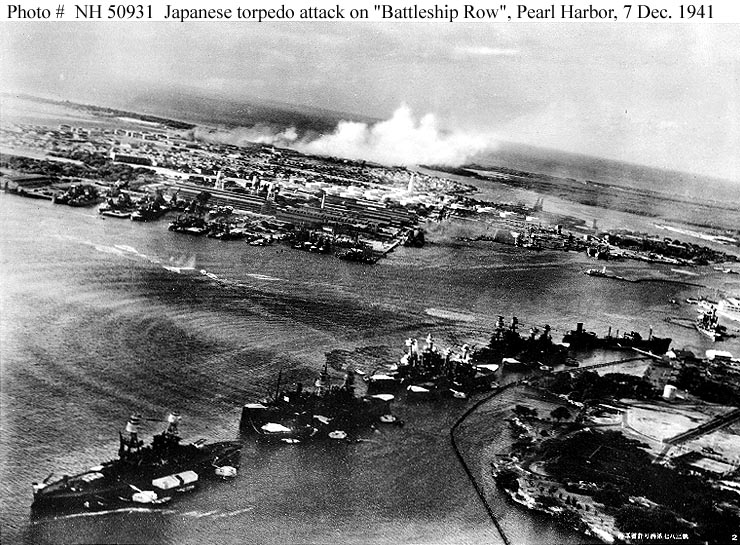|
Moderated by NW Okie! |
Volume 16 , Issue 422014Weekly eZine: (374 subscribers)Subscribe | Unsubscribe Using Desktop... |
1941, December 1941, Pearl Harbor Attack

The image is a view of Japanese torpedo attack on Battleship Row, Pearl Harbor at about 0800 on 7 December 1941. Views from a Japanese aircraft. Ships are, from lower left to right: Nevada (BB-36) with flag raised at stern; Arizona (BB-39) with Vestal (AR-4) outboard; Tennessee (BB-43) with West Virginia (BB-48) outboard; Maryland (BB-46) with Oklahoma (BB-37) outboard; Neosho (AO-23) and California (BB-44). West Virginia, Oklahoma and California have been torpedoed, as marked by ripples and spreading oil, and the first two are listing to port. Torpedo drop splashes and running tracks are visible at left and center.
White smoke in the distance is from Hickam Field. Grey smoke in the center middle distance is from the torpedoed USS Helena (CL-50), at the Navy Yard's 1010 dock. Japanese writing in lower right states that the image was reproduced by authorization of the Navy Ministry.
73 Years Ago, 7 Dec. 1941, Sunday, 7 December 2014, marked the 73rd anniversary of the Japanese surprise attack against the American naval base at Pearl Harbor, Hawaii, on 7 December 1941 that struck a critical blow against the U. S. Pacific fleet and drew the Untied States irrevocably into World War II.
It was reported that diplomatic negotiations with Japan had broken down, President Franklin Roosevelt and his advisers knew that an imminent Japanese attack was probable, but nothing had been done to increase security at the important naval base at Pearl Harbor.
That Sunday morning, 7 December 1941, many military personnel had been given passes to attend religious services off base. At 7:02 a.m., two radar operators spotted large groups of aircraft in flight toward the island from the north, but, with a flight of b-17s expected from the Untied States at the time, they were told to sound no alarm. Thus, the Japanese air assault came as a devastating surprise to the naval base.
It was reported 73 years ago, the day after Pearl Harbor was bombed, President Roosevelt appeared before a joint session of Congress and declared, "Yesterday, December 7, 1941 . . . a date which will live in infamy . . . the United States of America was suddenly and deliberately attacked by naval and air forces of the Empire of Japan." After a brief and forceful speech, Roosevelt asked Congress to approve a resolution recognizing the state of war between the United States and Japan. The Senate voted for war against Japan by 82 to 0, and the House of Representatives approved the resolution by a vote of 388 to 1. The sole dissenter was Representative Jeannette Rankin of Montana, a devout pacifist who had also cast a dissenting vote against the U.S. entrance into World War I. Three days later, Germany and Italy declared war against the United States, and the U.S. government responded in kind.
Click this link for more information, images and overview of the Pearl Harbor Attack, 7 December 1941.
| View or Add Comments (0 Comments)
| Receive
updates ( subscribers) |
Unsubscribe
| © . Linda Mcgill Wagner - began © 1999 Contact Me | |
